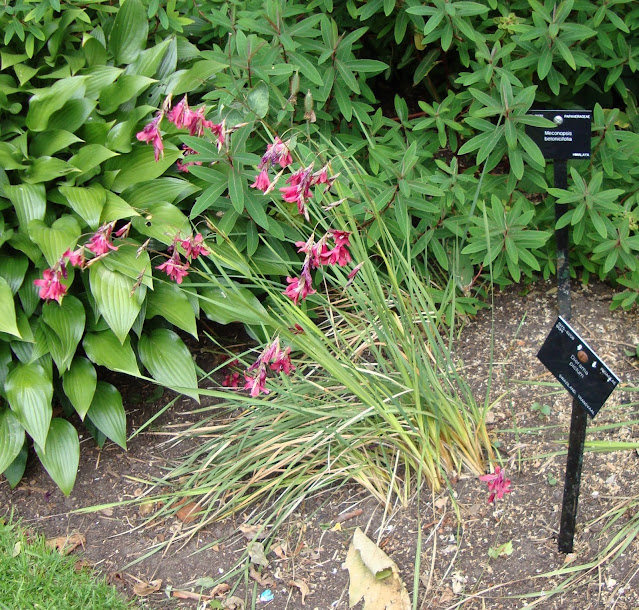In these COVIDious days, the weeks stretch into months, and years trickle by at a different pace: I dropped my five part retrospective of Kew on her 250th anniversary many weeks ago: if you click back you will see dozens--perhaps more than a hundred images I took 11 years go. When will we have the privilege of travel once again? It does make one nostalgic and sad to think of it... Oh yes,l the Victoria waterlily in its very appropriate domicile!
The label reads "Dierama pictum" from Swaziland and "Transvaal"-- a bit of a historical kickback!
A strange pale blue Amsonia (see the next frame) whose label I stupidly forgot to photograph.
 |
| Rubus illecebrosus |
I love the fringe of Mexican hybrid penstemon along the base of the greenhouse--and the romping toddler.
An amazing grafted tree trunk!
 |
| Pterocarya (Wingnut) |
Our first encounter with this strange relative of the walnut: I stupidly didn't photograph the label--but checking the "Monumental trees of England", they only list P. stenoptera as growing near the Waterlily house (the Web is amazing) and I have a hunch that this is it.
I'm not sure who was more amazed with this specimen--Mike or myself! Look at that trunk! I regret I didn't ask about the genus when I was in the Caucasus--taxa from there are more apt to be hardy in Colorado.
A glimpse of the Lavender field outside the grand Conservatory.
Is there a better measure of the commitment of an institution than that they've maintained a plant in a pot continuously for two and a half centuries: I was humbled to photograph it (see below)
 |
| Encephalartos alstensteinii |
Another glimpse of the same--with others in front of us (it's popular)...
I have a fondness for lavender...
More unusual bedding plants.
The Orangerie--not too many oranges in it nowadays!
A fuzzy photo (sorry) of a caged Wollemia nobilis...poor thing!
A very Kewian explanation. Sometimes the British reveal their Germanic ancestry: I loved the exhaustive signage in German botanic gardens. In America, signs are aimed at gum chewers.
 |
| Robinia pseudoacacia |
I was shocked at the size of the Black locust! You never see monsters like this here in borer country.
 |
| Araucaria araucana |
There are lots of monkey puzzles in Britain--but not many showcased like THIS!
You don't want to be bonked by this strobilis: I have read that people can be badly wounded by seed-bearing cones weighing many pounds falling on their heads.
Not everything at Kew is plants plants plants--sometimes it's architecture and plants.
 |
| Hebe sp. |
Or this amazing shrub along the walkway.
The massed shrub and tree borders create wonderful vistas...
More palms and simple design as we return to the Princess of Wales conservatory
Wouldn't you like to have a grove of tree ferns near YOUR conservatory?
I chuckled to see Mexican feather grass--which I'm exiling from MY garden...snicker.
Oh yes, a long border of pitcher plants. Just the thing.
I wish I'd thought of this!
 |
| Alstroemeria aurea |
In our Pacific states this is considered a noxious weed: I have grown it, but it has not been weedy here (alas)
 |
| Alstroemeria aurea |
I've admired this in Argentina, fringing woodlands in Patagonia.
 |
| Alstroemeria aurea |
Common and even weedy it may be--but I love it as you can see.
 |
| Echium sp. |
I also forgot to photograph the label of this gorgeous borage...I'd love to grow it!
 |
| "Haplopappus reidesii" |
I too have received this Erigeron under this peculiar name: there are currently no Haplopappus recognized from North America, and those that were are all yellow/orange flowered. As for the specific name: there is no Asteraceous taxon in North America whose specific name begins with "rei" or "rie" or any other permutation. Even Homer nods. (I think this is a form of Erigeron glaucus)
 |
| Iris wilsonii |
I am more apt to believe THIS labeled plant: this is one of the two rarely seen yellow Siberian iris, albeit this comes from China and not Siberia. I was thrilled to see this rarely encountered iris.
 |
| Pelargonium sidoides |
Not a very impressive picture--but one of my favorite plants: the black pelargonium of the Drakensberg--heavily harvested for herbal medicine, alas, in nature.
As at Wisley, you must go through the gift shop, chockablock full of irresistible things--especially books in my case! Harrumph.
When I took this, orchids were not as commonplace as they've become at Trader Joes etc.
This gentleman seems to be resisting the displays...
We've escaped the enclosure of Kew--but the neighborhood around it is almost as densely planted with beautiful and unusual flowers, like this dark pink Lavatera.
And a very striking, very double rose (without the Kew label alas)
And a fine planting of tree ferns as we walk to the "Underground"
It would appear to my eyes that this purple Cordyline australis is not an annual....
And so we end...even the neighborhood around Kew in Richmond is a botanical treasure trove! Let's hope not too many years go by before we all can visit once again!










































Do they wrap their tree ferns during winter? The "oldest potted plant in the world" gave me goosebumps. The stories it could tell...
ReplyDeleteI believe these tree ferns are quite hardy, Grace: I doubt they protect them. Lots of things at Kew can give one goosebumps. The place reeks of history in its best manifestations! Kew seems to get better with age!
ReplyDelete